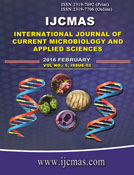


 National Academy of Agricultural Sciences (NAAS)
National Academy of Agricultural Sciences (NAAS)

|
PRINT ISSN : 2319-7692
Online ISSN : 2319-7706 Issues : 12 per year Publisher : Excellent Publishers Email : editorijcmas@gmail.com / submit@ijcmas.com Editor-in-chief: Dr.M.Prakash Index Copernicus ICV 2018: 95.39 NAAS RATING 2020: 5.38 |
Ventilator-associated pneumonia (VAP) is considered as a leading cause of infection related mortality and morbidity in intensive care units (ICUs) together with increasing the length of ICU stay and rising the cost of antibiotic treatment of VAP especially in developing coutries. Education of ICU healthcare providers is widely viewed as a fundamental measure in reducing VAP. So, this study aimed to improve health outcome of patients on mechanical ventilation through decreasing ventilator associated pneumonia in surgical intensive care unit at Zagazig University Hospitals through the following 1-To assess knowledge of health care providers in surgical intensive care units about the guidelines recommended by Association for Professionals in Infection Control & Epidemiology (APIC) to decrease ventilator associated pneumonia before and after health education intervention. 2- To calculate incidence rate of ventilator associated pneumonia in surgical intensive care unit over a period of six months before and six months after intervention. 3-To estimate length of ICU stay of ventilator associated pneumonia patients in surgical intensive care unit over a period of six months before and six months after intervention. 4-To estimate costs of antibiotic treatment of VAP in surgical intensive care unit over a period of six months before and six months after intervention a quazi experimental (pre-post test) study was conducted in surgical ICU at Zagazig University Hospital during the years 2014-2015. All health care providers in this unit (10 physicians & 29 nurses) were included in the study. All Patients on mechanical ventilation were consecutively enrolled in during the period of the pre and post intervention phases (82 &84) respectively. Two constructed questionnaires were answered to assess their knowledge about HAIs and VAP prevention measures before and after the intervention. The VAP incidence rate, length of stay (LOS) and cost of antibiotic treatment were calculated during each of pre and post intervention phases. The educational program involved physicians and nurses and included a message covering the guidelines recommended by Association for Professionals in Infection Control and Epidemiology (APIC). In the 1st phase, 31.7% of ventilated patients developed VAP while in the post intervention phase after the intervention, only 16.7% of patients were diagnosed as VAP cases with a statistically significant difference. The VAP incidence rate dropped by 25.7% from 29.5 VAP cases/1000 vent. days in phase 1 to 21.5 in phase 2. As regards to the LOS and the cost of antibiotic treatment of VAP, no statistically significant difference is found between both phases The effect of educational intervention on total knowledge improvement of physicians, knowledge about hospital acquired infection and VAP prevention measures improved significantly while knowledge of nurses improved significantly regarding HAI, VAP and VAP prevention measures. this study revealed that a relatively simple education program for implementation of guidelines recommended by APIC reduced the incidence rate of ventilator associated pneumonia in intensive care unit. 1.Continuous health education and training of ICU healthcare personnel regarding the knowledge, attitude and practice towards general infection control guidelines in the intensive care units, ventilator associated pneumonia (VAP) and the periodically updated evidence based guidelines for its prevention.2. Reevaluation of the intensive care unit policy to adopt the APIC prevention guidelines of VAP and other evidence based bundles for the prevention of different hospital acquired infections in the ICU.3. Standardize the case definition and the management protocol of VAP in all intensive care units.4. Enhancing appropriate use of antimicrobial treatment in the ICU setting to reduce antibiotic resistance and cost and to improve the patient’s clinical response.5. Conduct more specific economic studies with longer follow up periods for evaluation of the economic cost and impact of VAP.6. Proper and full recording of different aspects of Zagazig hospital’s costs for each department to facilitate economic or financial study analysis.
 |
 |
 |
 |
 |